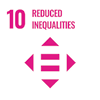Global inequality refers to substantial disparities in income and wealth distribution across the world’s population or between countries. While descriptive statistics highlight the scale, patterns, and trends of inequality, they cannot provide us with an understanding of how citizens of low-income countries can catch up to the living standards of high-income countries over time, where economic growth is sustainable and inclusive.
This project aims to expand empirical evidence on inequality patterns, and examine major contemporary and future drivers of global inequality. It explores the persistence of inequality due to group-based disadvantages, such as racial or ethnic injustice, and the challenges posed by climate change in achieving GDP per capita convergence between countries during the transition to global net-zero carbon emissions by 2050—a period referred to as ‘green economic transformation’.
Exploring patterns of inequality
The focus on developing the World Income Inequality Database (WIID) continues. For over two decades, UNU-WIDER has compiled, updated, and maintained the WIID, making it a critical resource for researchers studying global inequality. The recent UNU-WIDER work programme (2019–23) expanded the WIID to include a harmonized set of comparative income inequality statistics and a complete picture of the global income distribution to the percentile level. Plans are underway to further advance the WIID to analyse within- or across-group income inequalities and provide national measures of intergenerational mobility.
Understanding the drivers of inequality
A critical puzzle today is environmentally sustainable industrialization. Between-country inequality stems from disparate income levels between rich and poor countries. Historically, economic growth is linked with structural transformation—where workers transition from low-productivity activities like agriculture to higher-productivity sectors like manufacturing and services.
However, this shift has traditionally increased energy use, predominately from fossil-fuels, which are vital for industrialization. Promoting manufacturing within a carbon-constrained world must balance sustainability and net-zero emission (NZE) targets with creating employment and income opportunities in Global South countries. This project will examine green economic transformation opportunities and challenges and how late-industrializing countries like India, Indonesia, South Africa, and Brazil can tailor their industrial strategies to green industrialization.
Key Questions
- What are the global and national patterns and trends in inequality?
- How do group inequality and intergenerational mobility vary across countries?
- What is the future trajectory of economic growth and structural transformation, and how might it reduce global inequality through the convergence of living standards between rich and poor countries? What are the implications of potentially high economic growth for low- and middle-income countries for net zero emission targets?
- What role do industrial policies play in fostering green economic transformation? What specific types of demand and supply side strategic interventions are needed for low- and middle-income countries to follow zero carbon pathways?
This project has three major subcomponent work areas
Group-WIID
With more unit-level datasets available from the Luxembourg Income Study (LIS) and the World Bank’s new Poverty and Inequality Platform (PIP), the WIID will expand its functionality to analyse within-country inequalities by demographic groups. For example, we can now estimate income or consumption inequality over time by area (rural/urban), geographical region, and ethnic or racial groups. Almost no other global databases provide easy access to within-country inequality measures and WIID can come to serve an important need in this regard.
National levels of intergenerational mobility included in the WIID
A lack of comprehensive panel data in many countries limits the investigation of income mobility. With a new methodology introduced by Ray and Genicot (2023) to measure levels of upward mobility in data-poor settings, we expect to provide estimates of upward mobility for the group of understudied low- and middle-income countries in the WIID database.
Green economic transformation
A collection of studies will explore the major thematic and political economy issues of sustainable convergence and provide case studies of the experiences of major emerging economies in the Global South. This collection of studies will ultimately be available in the form of a complete edited volume—edited by Nagesh Kumar, Imraan Valodia, and Kunal Sen—with research forming the basis for several policy briefs providing recommendations on green industrial policy in Global South countries. The collection provides a focus on a major, underexplored driver of the future trend in between-country inequality.
Watch this space
All the updates to the WIID, publications, activities, events, opportunities to engage, and other outputs of this project will be here.

 Join the network
Join the network





